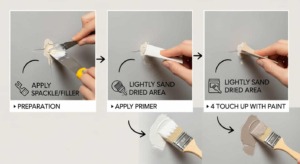It is entirely possible to keep painted walls, furniture or floors looking fresh for years without having to repaint. The secret is regular care and quick fixes. In practice, this means you should clean and dust gently, protect high-wear areas, and repair any chips or stains immediately. By following these steps, you can dramatically extend the life of your paint job. For example, high-quality interior latex paint can stay vibrant for up to a decade if you care for it properly. In the rest of this guide, we’ll show you the key tips – from gentle cleaning to protective coatings – that paint professionals recommend for long-lasting color.
Start with a Durable Paint Job
Before worrying about maintenance, make sure the paint itself is up to the task. A good paint job begins with thorough prep and quality materials. Clean, sand, and prime surfaces before painting; professionals agree that poor preparation can cause peeling and cracking later. Using a high-grade paint and primer will also pay off: premium exterior paints can last 10–15 years, and even interior walls last much longer with quality products. In short, the better your paint and prep, the less often you’ll ever need to repaint.
Clean and Inspect Regularly
Dust and dirt buildup is paint’s enemy, so make cleaning part of your routine. Aim to dust walls and trim about once a week with a soft cloth or duster. This simple step prevents grime from embedding in the paint and dulling the finish. For smudges and stains, use gentle cleaners. A few drops of mild dish soap (like Dawn) in a bucket of warm water usually does the trick. Wipe spots softly with a sponge or microfiber cloth, then rinse with clean water and dry to avoid streaks.
- Dust first: Remove loose dust with a soft cloth or vacuum brush before you apply any liquid cleaner.
- Mild soap solution: Mix a little dish soap into warm water. Gently wash the wall starting from the bottom and moving up. This helps prevent drips or streaks.
- Rinse and dry: After washing, go over the area with a clean damp cloth to remove soap residue, then wipe dry. This prevents dull spots from leftover soap.
- Avoid scrubbing: Never use abrasive pads or harsh chemical cleaners. They can strip paint or leave shiny marks on matte finishes. Always opt for soft cloths and gentle solutions.
Consistent cleaning pays off. In fact, paint experts warn that stains left too long can set in permanently. So wipe up spills or marks as soon as you see them. With this routine – weekly dusting plus prompt spot-cleaning – your paint will stay clean and bright much longer.
Regular cleaning is key to paint longevity. Gently dust walls weekly and wash stains with mild soap, then rinse and dry. This prevents dirt from dulling the paint. Notice the soft sponge and gentle approach in this photo – avoid harsh scrubbing!
Fix Chips and Cracks Immediately

Even with the best care, small accidents happen. A chipped corner or tiny crack on a wall can become a big peeling problem if ignored. Inspect your painted areas now and then, especially after moving furniture or hanging pictures. At the first sign of damage, do a quick repair:
- Patch holes and cracks: Use a good-quality spackle or wall filler on any dents or nail holes. Once it dries, sand it smooth. Then prime the patch if needed and touch up with matching paint. This stops the chip from spreading.
- Touch up paint: Keep a sample of your paint or note the color name. Blending a little of the original paint over the repair is the best way to hide the fix. Painting over a patch immediately keeps the finish uniform and prevents old paint from flaking away.
- Prevent big jobs: Regular small repairs mean you won’t need a full repaint. As one painting guide advises, “address minor imperfections promptly to maintain the integrity of your paint job”.
Fixing tiny flaws as they appear is a little effort that goes a long way. It keeps the painted surface intact so moisture or dirt can’t sneak under the paint.
Use Protective Coatings and Coverings
Some surfaces benefit from an extra shield. For example, apply a clear topcoat to painted areas that see heavy use or weather. A clear acrylic or polyurethane sealant can block UV light and moisture, protecting the paint underneath. If you painted a deck or exterior trim, a UV-resistant sealer or clear stain will keep the color from fading and help repel water. Indoors, many people use enamel-based or washable paints in kitchens and bathrooms – but you can also add a clear acrylic sealer over latex paint in those spots for extra durability.
Another simple trick is using rugs and pads to protect painted floors and lower walls. For instance, placing a mat at an entryway traps dirt before it scratches a painted floor. Felt pads under chair legs and furniture prevent gouges in the finish. In the living room or playroom, scatter rugs or furniture glides can save painted hardwood or tile from endless scuffs. These little barriers absorb the abuse that would otherwise chip or dull the paint.
Use mats and pads to spare your paint. For example, a decorative rug at the door and felt pads under chairs can protect painted floors from scratches. In the photo above, a cozy rug helps keep the wood floor’s finish clean. Simple coverings like this prevent everyday wear on painted surfaces.
Guard Against Weather and Wear
Finally, think about environmental factors. Move water away from paint: Make sure rain gutters and downspouts channel water well away from painted walls. Overflowing or clogged gutters can splash water onto paint, leading to mildew or peeling. Also trim back plants and vines: leaves or branches rubbing on paint can scuff the surface, and constant moisture from damp foliage can dull or rot the paint over time.
Indoors, control humidity and sunlight. Use exhaust fans in steamy rooms (like bathrooms and kitchens) so condensation won’t bubble or strip paint. Wipe up any dampness on walls right away. If a room gets very strong sun, consider UV-filtering window film or curtains – even interior paint can fade slightly over many years in direct sun.
In short: Keep your painted areas dry and shaded when possible. Clean your gutters, trim foliage, and ventilate steamy rooms. These steps prevent the two main enemies of paint: moisture and UV.
Summary
By following these simple habits – gentle cleaning, protective treatments, and quick repairs – you’ll lock in your paint’s lifespan. Little efforts like weekly dusting or putting down a welcome mat pay off big. Even experts agree: “regular maintenance makes a difference,” whether it’s cleaning walls or fixing chips. With consistent care, you can confidently say your paint job will last for years without full repainting.
Ready to keep your home’s paint looking new? For extra protection, check out SureCoat’s line of durable paints and sealants at SureCoatPaint.com. Our products are designed for long-lasting color and easy maintenance – helping your surfaces stay vibrant and damage-free much longer. Keep your home beautiful and repaint far less often with SureCoat!


